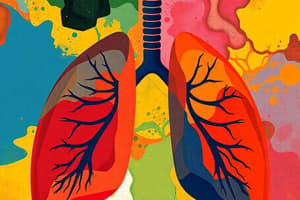Podcast
Questions and Answers
Match the type of respiratory failure with its description:
Match the type of respiratory failure with its description:
Acute Respiratory Failure = Results from inadequate gas exchange for a short period Chronic Respiratory Failure = The respiratory failure which passes the acute stage
Match the classification with the correct type of Acute Respiratory Failure:
Match the classification with the correct type of Acute Respiratory Failure:
Hypoxemic respiratory failure = An arterial oxygen tension lower than 60 mm Hg with a normal or low arterial carbon dioxide tension Hypercapnic respiratory failure = CO2 higher than 50 mm Hg
Match the causes with the conditions affecting respiration:
Match the causes with the conditions affecting respiration:
Diseases that affect the lungs = COPD (chronic obstructive pulmonary disease), pneumonia, and COVID-19 Conditions affecting nerves and muscles controlling breathing = Spinal cord injuries and stroke
Match the following symptoms with their type of Acute Respiratory Failure:
Match the following symptoms with their type of Acute Respiratory Failure:
Match the following terms with their definitions:
Match the following terms with their definitions:
Match the clinical manifestation with its description:
Match the clinical manifestation with its description:
Match the diagnostic study with its purpose:
Match the diagnostic study with its purpose:
Match the treatment with its description:
Match the treatment with its description:
Match the nursing management action with its description:
Match the nursing management action with its description:
Match the complication with its related issue:
Match the complication with its related issue:
Flashcards are hidden until you start studying
Study Notes
Respiratory Failure Classification
- Acute Respiratory Failure (ARF) classified into two types: Hypoxemic and Hypercapnic
Hypoxemic Respiratory Failure
- Characterized by inadequate oxygenation of the blood
- PaO2 < 60 mmHg
- Causes: Pneumonia, Pulmonary Edema, Cardiogenic Shock, and COPD
Hypercapnic Respiratory Failure
- Characterized by inadequate ventilation and increased CO2 levels
- PaCO2 > 50 mmHg
- Causes: Respiratory Muscle Weakness, CNS Depression, and Airway Obstruction
Causes of Respiratory Failure
- Pneumonia: bacterial or viral infection of the lungs
- Pulmonary Edema: fluid accumulation in the lungs
- Cardiogenic Shock: inadequate blood flow and oxygenation
- COPD: chronic obstructive pulmonary disease
- Respiratory Muscle Weakness: weakened respiratory muscles
- CNS Depression: decreased central nervous system activity
- Airway Obstruction: blockage of the airway
Symptoms of Respiratory Failure
- Hypoxemic: dyspnea, tachypnea, cyanosis, and confusion
- Hypercapnic: somnolence, headache, and seizures
Diagnostic Studies
- ABG (Arterial Blood Gas): measures oxygen and carbon dioxide levels
- Chest X-ray: evaluates lung structure and function
- Pulse Oximetry: non-invasive measurement of oxygen saturation
Treatment of Respiratory Failure
- Oxygen Therapy: increases oxygen levels in the blood
- Mechanical Ventilation: assists with breathing and oxygenation
- Medications: bronchodilators, sedatives, and analgesics
Nursing Management
- Monitor vital signs and ABG results
- Maintain patent airway and oxygenation
- Administer medications and oxygen therapy
Complications of Respiratory Failure
- Respiratory Acidosis: increased CO2 levels leading to acidosis
- Cardiac Arrest: inadequate oxygenation and perfusion
- Pneumonia: secondary infection of the lungs
Studying That Suits You
Use AI to generate personalized quizzes and flashcards to suit your learning preferences.





